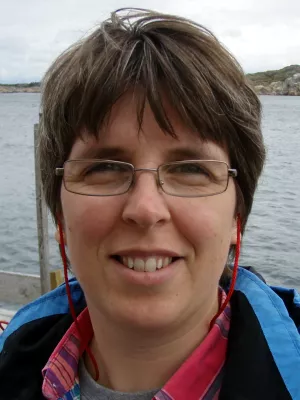
Helena Alexanderson
Professor

Aeolian activity in Sweden: an unexplored environmental archive
Author
Summary, in English
During the course of this three-year project, we have studied aeolian deposits at 70 sites within sixteen areas in south-central Sweden. Inland dunes have been the focus, but some sites with coversand and coastal dunes have also been investigated. We have mapped dune morphology, mainly by LiDAR-based remote sensing, studied the internal sediment architecture by ground-penetrating radar profiling and in sediment exposures, documented the sedimentology of the deposits with field and laboratory methods as well as determined the age of the deposits with luminescence and radiocarbon dating. In this scientific report to the Geological Survey of Sweden, who funded the project, we present a summary of the project and its results.
The largest and best developed dune fields are found at glacifluvial deposits in Värmland and Dalarna, while in areas south thereof there are mainly scattered dunes or coversand deposits. A range of dune types has been observed, but transverse dunes seem to be dominating and the majority of these are oriented roughly NE-SW. The bulk of the aeolian deposits were formed shortly after the local deglaciation and, once stabilised, do not appear to have been significantly reworked during the Holocene. Most Mid- and Late-Holocene aeolian deposits consist of coversand, apart from in coastal areas where e.g. young foredunes are found.
Our results thus largely confirm the hypothesis of previous investigators but we do add a significant amount of new information. We provide, for the first time for most of our study areas, numerical ages for the aeolian deposits and thus provide the timing and duration of sand-drift events in south-central Sweden. The ages, in combination with detailed geomorphological mapping, allow us to distinguish phases of dune-field development, which are likely due to changes in wind patterns and vegetation cover, and also to correlate Swedish aeolian deposits to regional storminess periods. Based on sedimentological information we are able to reconstruct dominating depositional processes, transport paths and sediment sources. Additional outcomes of the project are e.g. methodological developments (LiDAR mapping, luminescence dating) and pilot studies of potential relevance for applied geology (coastal development).
The largest and best developed dune fields are found at glacifluvial deposits in Värmland and Dalarna, while in areas south thereof there are mainly scattered dunes or coversand deposits. A range of dune types has been observed, but transverse dunes seem to be dominating and the majority of these are oriented roughly NE-SW. The bulk of the aeolian deposits were formed shortly after the local deglaciation and, once stabilised, do not appear to have been significantly reworked during the Holocene. Most Mid- and Late-Holocene aeolian deposits consist of coversand, apart from in coastal areas where e.g. young foredunes are found.
Our results thus largely confirm the hypothesis of previous investigators but we do add a significant amount of new information. We provide, for the first time for most of our study areas, numerical ages for the aeolian deposits and thus provide the timing and duration of sand-drift events in south-central Sweden. The ages, in combination with detailed geomorphological mapping, allow us to distinguish phases of dune-field development, which are likely due to changes in wind patterns and vegetation cover, and also to correlate Swedish aeolian deposits to regional storminess periods. Based on sedimentological information we are able to reconstruct dominating depositional processes, transport paths and sediment sources. Additional outcomes of the project are e.g. methodological developments (LiDAR mapping, luminescence dating) and pilot studies of potential relevance for applied geology (coastal development).
Department/s
- Quaternary Sciences
Publishing year
2016-08-26
Language
English
Publication/Series
LUNDQUA Report
Full text
Document type
Report
Publisher
Department of Geology, Lund University
Topic
- Geology
Keywords
- aeolian
- Luminescence dating
- Sweden
Status
Published
Project
- Aeolian activity in Sweden: an unexplored environmental archive
Report number
42
ISBN/ISSN/Other
- ISSN: 0281-3076
- ISBN: 978-91-87847-23-3

